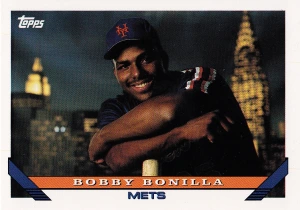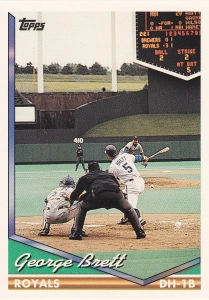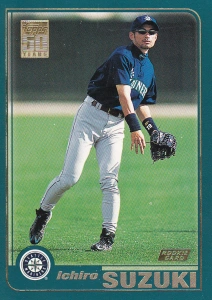Highlights and Events:
The offseason prior to 1988 saw some of the first tangible results from the collusion cases. An arbitrator ruled against the owners on the Collusion 1 case, rewarding $10.5 million to the players and declaring seven free agents from the 1985-1986 off-season as “no-risk” free agents who had between the end of January until March 1 to sign with new teams even though they had a contract with their existing team. Kirk Gibson was by far the most notable; like Andre Dawson had done the year before, he would become the National League MVP after signing with a new team.
 However, the owners were still operating under some level of collusion – they were sharing contract offers in an “information bank”. There still wasn’t significant free agency movement, and for the third offseason in a row, the MLBPA filed another grievance against the owners. The most noteworthy move aside from Gibson was Jack Clark, who was coming off a 3rd-place MVP finish, who signed with the Yankees.
However, the owners were still operating under some level of collusion – they were sharing contract offers in an “information bank”. There still wasn’t significant free agency movement, and for the third offseason in a row, the MLBPA filed another grievance against the owners. The most noteworthy move aside from Gibson was Jack Clark, who was coming off a 3rd-place MVP finish, who signed with the Yankees.
A few trades would have impacts on the next few fall classics – in addition to adding Gibson, the Dodgers sent Bob Welch to the A’s in a 3-team deal where they received Jesse Orosco. The A’s also got Dave Parker from the Reds, giving up future WS MVP Jose Rijo in the deal. The Cubs sent reliever Lee Smith to Boston, primarily in exchange for starter Calvin Schiraldi.
The Baltimore Orioles created a new record of futility to start the season. The O’s lost 21 straight out of the gate, and the losses cost Cal Ripken Sr. his job at the helm. Former Oriole great Frank Robinson was hired, but the firing did create some tension with star SS Cal Ripken Jr.
 While guiding the Reds to another 2nd place finish, Pete Rose drummed up some controversy (though less than he would 1 year later) when he got into an argument with umpire David Pallone in an April 30th game against the Mets. Rose pushed Pallone and set off a frenzy in Riverfront Stadium and a tirade by the Reds announcers. Rose was suspended 30 games by then-NL President Bart Giamatti. This was the largest suspension of a manager ever for an on-field incident, and set a stage for a bigger fight between Rose and Giamatti one year later.
While guiding the Reds to another 2nd place finish, Pete Rose drummed up some controversy (though less than he would 1 year later) when he got into an argument with umpire David Pallone in an April 30th game against the Mets. Rose pushed Pallone and set off a frenzy in Riverfront Stadium and a tirade by the Reds announcers. Rose was suspended 30 games by then-NL President Bart Giamatti. This was the largest suspension of a manager ever for an on-field incident, and set a stage for a bigger fight between Rose and Giamatti one year later.
The ’88 season saw a number of near-misses on no-hitters. During Rose’s suspension, Reds pitcher Ron Robinson nearly hurled a perfect game. On May 2, Robinson had retired the first 26 batters at home against the Expos. He gave up a single to Wallace Johnson and Tim Raines immediately followed with a home run. Robinson was relieved, and the Reds held on 3-2. 7 other games saw no-hitters broken up in the 9th inning:
- Nolan Ryan – with 1 out in the 9th on 4/27 against the Phillies, by Mike Schmidt
- Doug Drabek – on 5/8, Randy Ready of the Padres broke up the no-no to lead off the 9th
- Odell Jones – on 5/28, Ron Washington of Cleveland ended the no-hitter with 1 out in the 9th
- Tom Browning – Browning also nearly no-hit the Padres, giving up a hit to Tony Gwynn with 1 out in the 9th on 6/6
- Mike Scott – by Ken Oberkfell of Atlanta ended his bid with 2 out in the 9th on 6/12
- Dave Stieb – Stieb took both of his last 2 starts of 1988 hitless through 2-outs in the 9th. He is the only pitcher to have this happen back-to-back, which is nearly as impressive as Johnny Vander Meer’s feat as the only pitcher with back-to-back no-hitters.
Browning would have redemption on September 16th, however. At home in Riverfront Stadium against the Dodgers, he hurled the 12th perfect game in Major League history. Browning threw 72 of his 102 pitches for strikes, never went to a 3-ball count, winning 1-0. Browning (18-5) and Danny Jackson (23-8) formed the best pitching duo in the National League.
 Jackson had a year that would have won the Cy Young almost any other year. However, Orel Hershiser had a year, and particularly a finish, for the ages – he was, along with Jose Canseco, the biggest story in baseball. Hershiser also went 23-8 with a 2.26 ERA. After losing a game August 14th, Hershiser’s ERA went over 3 for the first time all year. In the remaining 9 starts, Hershiser had the most incredible stretch by a pitcher in modern history. He threw 8 complete games and 6 shut outs – the only game he didn’t finish was the finale that went 12 innings. He did not give up a run in the month of September, throwing 5 straight shut outs and going into his final start needing another shutout to match Don Drysdale’s all-time record of 58 scoreless innings. Hershiser and Andy Hawkins both held their opponents scoreless in regulation, and Hershiser shut down the Padres in the 10th to set the record. His stretch run helped propel the Dodgers to the National League West crown.
Jackson had a year that would have won the Cy Young almost any other year. However, Orel Hershiser had a year, and particularly a finish, for the ages – he was, along with Jose Canseco, the biggest story in baseball. Hershiser also went 23-8 with a 2.26 ERA. After losing a game August 14th, Hershiser’s ERA went over 3 for the first time all year. In the remaining 9 starts, Hershiser had the most incredible stretch by a pitcher in modern history. He threw 8 complete games and 6 shut outs – the only game he didn’t finish was the finale that went 12 innings. He did not give up a run in the month of September, throwing 5 straight shut outs and going into his final start needing another shutout to match Don Drysdale’s all-time record of 58 scoreless innings. Hershiser and Andy Hawkins both held their opponents scoreless in regulation, and Hershiser shut down the Padres in the 10th to set the record. His stretch run helped propel the Dodgers to the National League West crown.
 Jose Canseco was the story in the junior circuit. Canseco led all vote-getters in the All-Star game held at Riverfront, and had over 20 home runs and 20 stolen bases going into the break. He’d continue on that pace – his 2 steals on September 23rd gave him the first 40-40 season in ML history. Canseco led the league in HR, RBI and SLG, and the winning the MVP award and leading the Bash Brothers and Oakland to 104 wins and the AL West title. Oakland also got a standout performance from Dennis Eckersley, whose career seemed like it was close to over only 2 years earlier. The former All-Star starter saved 45 games and began a 5-year stretch where he was the most dominant closer baseball had ever seen.
Jose Canseco was the story in the junior circuit. Canseco led all vote-getters in the All-Star game held at Riverfront, and had over 20 home runs and 20 stolen bases going into the break. He’d continue on that pace – his 2 steals on September 23rd gave him the first 40-40 season in ML history. Canseco led the league in HR, RBI and SLG, and the winning the MVP award and leading the Bash Brothers and Oakland to 104 wins and the AL West title. Oakland also got a standout performance from Dennis Eckersley, whose career seemed like it was close to over only 2 years earlier. The former All-Star starter saved 45 games and began a 5-year stretch where he was the most dominant closer baseball had ever seen.
The A’s beat out the Twins, who couldn’t defend their World Championship, but did win more games (91) than the year before, and were led by Frank Viola’s 24-7 Cy Young season.
Canseco didn’t participate in the home run derby – no one did. For the only time, the event was canceled due to rain. The All-Star game followed suit as a pitching duel – the 8th man in the lineup proved the difference for the AL, as Terry Steinbach of the A’s hit a homer and knocked in both runs to win the game’s MVP.
The Mets bounced back from a disappointing 1987 season to pace the NL with 100 wins. They again had the best starting rotation in baseball – led by David Cone (20-3, 2.22 ERA), Dwight Gooden (18-9, started the All-Star game) and Ron Darling (17-9). Darryl Strawberry was the MVP runner-up and led the league with 39 homers.
The Red Sox won the last division title, taking the AL East with only 89 wins. Roger Clemens had another stellar season, going 18-12 and leading the league with 14 CG, 8 SHO and 291 K’s. Mike Greenwell was runner-up to Canseco as the MVP, but Wade Boggs was the team’s best player. Boggs hit .366 with a .476 OBP, winning his 5th batting title and becoming the first player in modern history with 6 consecutive 200-hit seasons (Wee Willie Keeler had 8 straight at the turn of the century, and Ichiro has 10 and counting).
 Both Chicago ballparks were in the news. In July, funding was passed to ensure the building of a new Comiskey Park on the South Side. Further North, lights were turned on in Wrigley Field for the first time ever on August 8th. As if the baseball Gods knew this was treacherous, the game was rained out. The next night, the first game was played under the lights at Wrigley, and the lovable losers beat the Mets.
Both Chicago ballparks were in the news. In July, funding was passed to ensure the building of a new Comiskey Park on the South Side. Further North, lights were turned on in Wrigley Field for the first time ever on August 8th. As if the baseball Gods knew this was treacherous, the game was rained out. The next night, the first game was played under the lights at Wrigley, and the lovable losers beat the Mets.
Baseball returned as a tournament to the Summer Olympics, again as a demonstration sport where the medals were not official. Played in Jamsil Stadium in Seoul, South Korea, 8 teams again competed in 2 “round robin” groupings. The top 2 teams from each division made the semi-finals, and the same 2 countries made the final. This time, however, the United States collegians extracted revenge on the Japanese, 5-3. One-armed pitcher Jim Abbott (Michigan) was the winning pitcher in the final, and the U.S. team also included future All-Stars Robin Ventura (Oklahoma St.), Tino Martinez (Tampa), Andy Benes (Evansville), Charles Nagy (Connecticut), Ed Sprague (Stanford) and Mickey Morandini (Indiana). Future MLB Rookie of the Year and All-Star starter Hideo Nomo pitched for the Japanese team.
Milestones reached in 1988 included:
- Mike Schmidt continued his move up the HR list, passing Mickey Mantle and Jimmie Foxx for 7th all-time.
- Bruce Sutter became the 3rd pitcher to convert 300 saves, and would finish his career with that exact total.
- Jeff Reardon saved 42 games for the Twins, becoming the first pitcher with 40-save seasons in both leagues.
- Bob Boone and Carlton Fisk became the first backstops to catch regularly at the age of 40 – and together they took home the American League hardware at the position. Fisk won the Silver Slugger award, while Boone won the Gold Glove in the Junior circuit.
Through 1987, Wade Boggs and Tim Raines were neck and neck for the title of best player in baseball. Boggs had another great year and outdistanced himself from the field; I’d jump him over Raines in 1988.
Roger Clemens was still the best pitcher in the game, though Hershiser’s phenomenal season put him in the argument. Frank Viola could also be considered with Hershiser, just behind Clemens.
In September, the pressure on Peter Ueberroth due to the collusion settlements had become too much. Ueberroth agreed to step down as commissioner after the 1988 season, and would be replaced by NL President Bart Giamatti. The playoffs started in 1988 with the knowledge that there would be new leadership the next year…
Read the rest of this entry »




















































